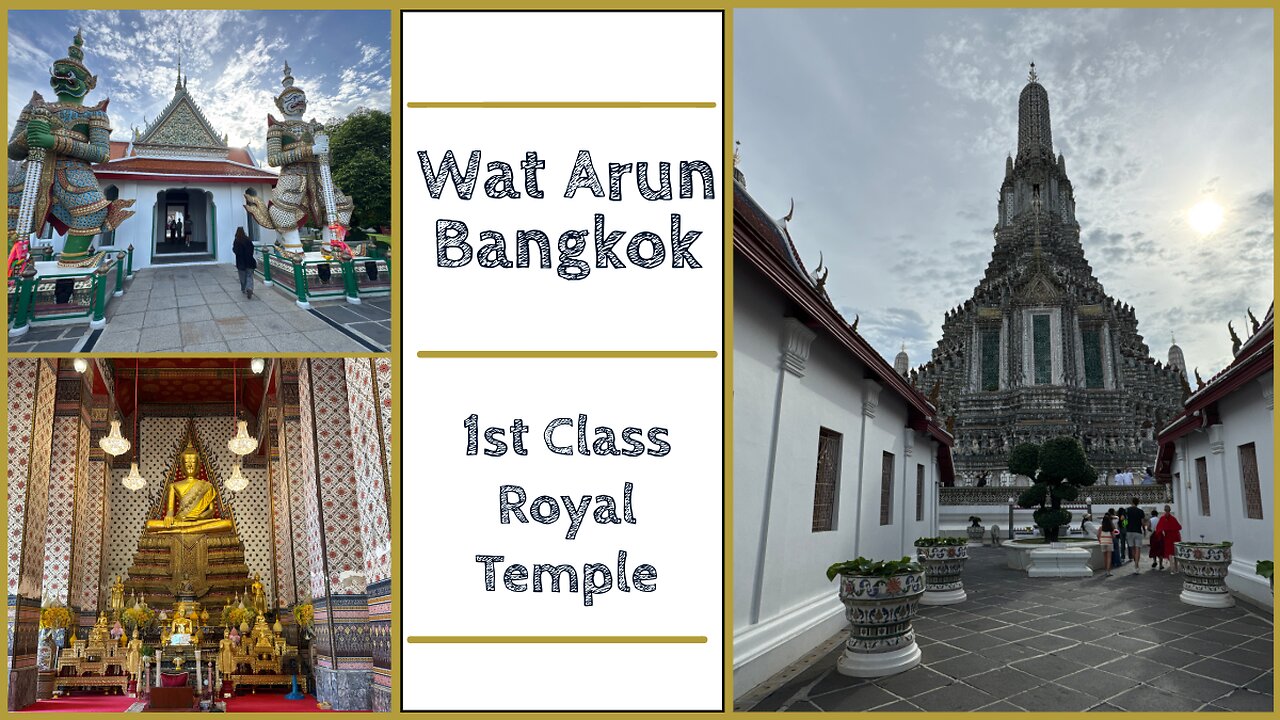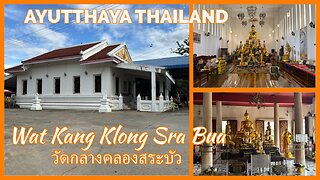Premium Only Content

Wat Arun - Temple of the Dawn - 1st Class Royal & One of Nine Sacred Temples - Bangkok Thailand 2025
Wat Arun, officially named Wat Arun Ratchawararam Ratchaworamahawihan, is a historic Buddhist temple located on the west bank of the Chao Phraya River in Bangkok, Thailand. Known as the Temple of Dawn, it is one of Thailand’s most iconic landmarks, renowned for its stunning riverside location, intricate architecture, and cultural significance.
The origins of Wat Arun date back to the Ayutthaya period (1351–1767), when it was a modest temple known as Wat Makok (Temple of the Olive), named after the tamarind trees in the area. It served as a local place of worship in what was then the village of Bang Makok, before Bangkok became the capital. The temple’s early history is tied to the broader religious and cultural landscape of the region, which was under the influence of the Ayutthaya Kingdom.
Wat Arun gained significant prominence during the Thonburi period (1767–1782) when King Taksin the Great, after the fall of Ayutthaya to the Burmese in 1767, established his new capital in Thonburi. King Taksin chose the temple to house the Emerald Buddha, Thailand’s most sacred relic, which was brought from Vientiane, Laos, in 1779. During this time, the temple was renamed Wat Chaeng (meaning “Temple of Dawn”) and served as the royal temple within the grounds of the Thonburi Palace.
When King Rama I founded the Rattanakosin Kingdom in 1782 and moved the capital across the river to Bangkok, the Emerald Buddha was relocated to Wat Phra Kaew in the new Grand Palace. Wat Arun lost its status as the royal temple but remained significant. It was during the reigns of King Rama II (r. 1809–1824) and King Rama III (r. 1824–1851) that the temple was extensively renovated and expanded, shaping its current iconic form.
The temple was renamed Wat Arun Ratchatharam and later Wat Arun Ratchawararam under King Rama IV (r. 1851–1868), reflecting its royal patronage. The name “Arun” is derived from Aruna, the Hindu god of dawn, symbolizing the temple’s radiant beauty at sunrise.
Throughout the 20th and 21st centuries, Wat Arun has undergone periodic restorations to preserve its delicate structures. Major renovations occurred in the 1980s and again between 2013 and 2017, addressing issues like weathering and structural instability in the prang. These efforts restored the temple’s intricate details, including its ceramic decorations, while maintaining its historical authenticity.
The defining feature of Wat Arun is its central prang, a Khmer-style tower standing approximately 67–86 meters tall (estimates vary). This monumental structure is designed to represent Mount Meru, the center of the universe in Buddhist and Hindu cosmology. The prang is characterized by:
• Stepped design: The tower has a square base with multiple tiers, narrowing as it rises, with steep staircases leading to upper terraces.
• Decorative elements: The prang is encrusted with colorful porcelain, ceramic tiles, and seashells, many of which were sourced from Chinese trading ships’ ballast during the 19th century. These materials create a mosaic-like effect that sparkles in the sunlight, particularly at dawn and dusk.
• Sculptures: The prang is adorned with figures of mythical creatures, such as kinaree (half-human, half-bird beings) and garudas, as well as floral motifs and deities from Buddhist and Hindu traditions.
The central prang is flanked by four smaller satellite prangs, creating a symmetrical quincunx layout, a common feature in Khmer-inspired architecture.
Located to the east of the prang, the ubosot houses the temple’s principal Buddha image, a seated Buddha crafted during the reign of King Rama II. The hall features murals depicting Buddhist narratives and is used for religious ceremonies.
The temple grounds feature statues of mythical guardians, such as yaksha demons and Chinese-style stone figures, reflecting the blend of Thai, Khmer, and Chinese artistic influences.
This is one of the 1st class royal temples and 9 sacred temples in Bangkok. It is a must see for anyone visiting the city.
Enjoy the video!
You can also see my videos on Rumble, Bitchute, Odysee and Subscribe Star. If you have any questions or comments and wish to contact me directly I can be reached by email at [email protected]
https://www.bitchute.com/channel/pYUe8EgYcUMc/
https://odysee.com/$/latest/@EndlessJourney
https://rumble.com/c/EndlessJourney
https://www.subscribestar.com/endless-journey
Follow me on Twitter @AEndlessJourney
#endlessjourney
#travel
#thailand
-
 7:58
7:58
Endless Journey
2 days agoWat Klang Khlong Sra Bua: Ayutthaya’s Serene Historic Temple
2 -
 LIVE
LIVE
TimcastIRL
3 hours agoLeftist Terror Attack On ICE In Dallas, Jimmy Kimmel Doubles Down Insulting MAGA | Timcast IRL
9,286 watching -
 LIVE
LIVE
Man in America
8 hours agoIs Starlink RIPPING Us Apart from the Inside Out? w/ Cory Hillis
941 watching -
 55:40
55:40
TheSaltyCracker
2 hours agoIdiots Chug Tylenol PT2 ReeEEStream 9-24-25
54.7K156 -
 LIVE
LIVE
Akademiks
3 hours agoYoung Thug Dissing YFN Lucci. Ready to Go back to Jail. Offset vs Cardi b
1,215 watching -
 7:07
7:07
Colion Noir
11 hours agoCalifornia Just Banned All Glocks
17.1K23 -
 LIVE
LIVE
Adam Does Movies
4 hours agoTalking Movies + Ask Me Anything - LIVE
128 watching -
 LIVE
LIVE
Jamie Kennedy
2 hours agoChoosing Good in a World Gone Dark | Ep 223 HTBITY with Jamie Kennedy
106 watching -
 LIVE
LIVE
SpartakusLIVE
5 hours ago#1 Challenge CHAMPION of WZ || Ridin' The GRAVY Train w/ GloryJean
287 watching -
 LIVE
LIVE
The Pascal Show
1 hour ago $0.46 earnedDISTURBING UPDATES! New Developments In The D4vd Celeste Case... Possible Celeste Sighting?!
110 watching